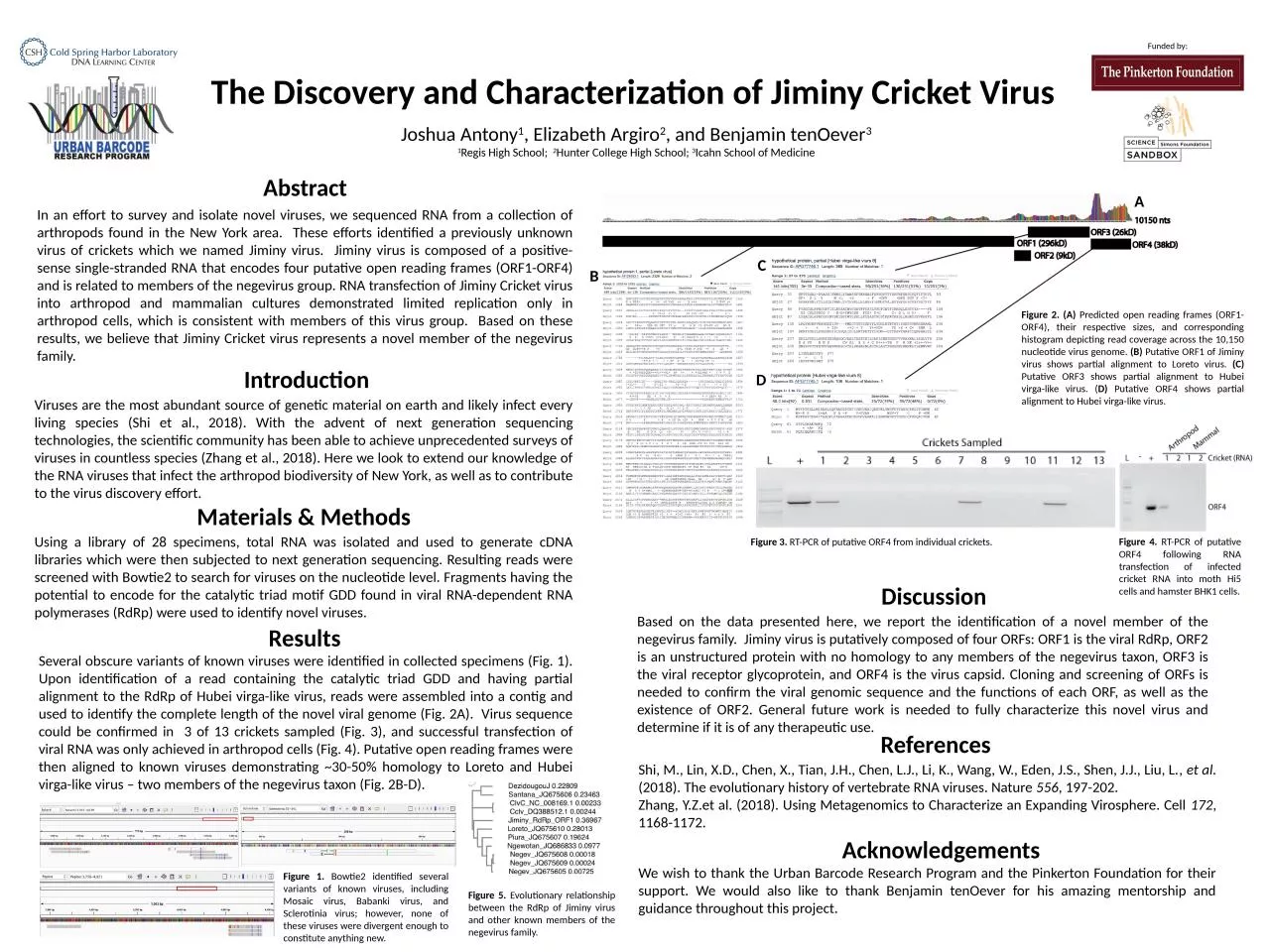

Joshua Antony 1 Elizabeth Argiro 2 and Benjamin tenOever 3 1 Regis High School 2 Hunter College High School 3 Icahn School of Medicine Abstract In an effort to survey and isolate novel ID: 1048580
Download Presentation The PPT/PDF document "The Discovery and Characterization of Ji..." is the property of its rightful owner. Permission is granted to download and print the materials on this web site for personal, non-commercial use only, and to display it on your personal computer provided you do not modify the materials and that you retain all copyright notices contained in the materials. By downloading content from our website, you accept the terms of this agreement.
1. The Discovery and Characterization of Jiminy Cricket VirusJoshua Antony1, Elizabeth Argiro2, and Benjamin tenOever31Regis High School; 2Hunter College High School; 3Icahn School of Medicine AbstractIn an effort to survey and isolate novel viruses, we sequenced RNA from a collection of arthropods found in the New York area. These efforts identified a previously unknown virus of crickets which we named Jiminy virus. Jiminy virus is composed of a positive-sense single-stranded RNA that encodes four putative open reading frames (ORF1-ORF4) and is related to members of the negevirus group. RNA transfection of Jiminy Cricket virus into arthropod and mammalian cultures demonstrated limited replication only in arthropod cells, which is consistent with members of this virus group. Based on these results, we believe that Jiminy Cricket virus represents a novel member of the negevirus family. IntroductionViruses are the most abundant source of genetic material on earth and likely infect every living species (Shi et al., 2018). With the advent of next generation sequencing technologies, the scientific community has been able to achieve unprecedented surveys of viruses in countless species (Zhang et al., 2018). Here we look to extend our knowledge of the RNA viruses that infect the arthropod biodiversity of New York, as well as to contribute to the virus discovery effort. Materials & Methods Using a library of 28 specimens, total RNA was isolated and used to generate cDNA libraries which were then subjected to next generation sequencing. Resulting reads were screened with Bowtie2 to search for viruses on the nucleotide level. Fragments having the potential to encode for the catalytic triad motif GDD found in viral RNA-dependent RNA polymerases (RdRp) were used to identify novel viruses. Discussion Based on the data presented here, we report the identification of a novel member of the negevirus family. Jiminy virus is putatively composed of four ORFs: ORF1 is the viral RdRp, ORF2 is an unstructured protein with no homology to any members of the negevirus taxon, ORF3 is the viral receptor glycoprotein, and ORF4 is the virus capsid. Cloning and screening of ORFs is needed to confirm the viral genomic sequence and the functions of each ORF, as well as the existence of ORF2. General future work is needed to fully characterize this novel virus and determine if it is of any therapeutic use. Funded by: ResultsSeveral obscure variants of known viruses were identified in collected specimens (Fig. 1). Upon identification of a read containing the catalytic triad GDD and having partial alignment to the RdRp of Hubei virga-like virus, reads were assembled into a contig and used to identify the complete length of the novel viral genome (Fig. 2A). Virus sequence could be confirmed in 3 of 13 crickets sampled (Fig. 3), and successful transfection of viral RNA was only achieved in arthropod cells (Fig. 4). Putative open reading frames were then aligned to known viruses demonstrating ~30-50% homology to Loreto and Hubei virga-like virus – two members of the negevirus taxon (Fig. 2B-D). Figure 1. Bowtie2 identified several variants of known viruses, including Mosaic virus, Babanki virus, and Sclerotinia virus; however, none of these viruses were divergent enough to constitute anything new.A B CDFigure 2. (A) Predicted open reading frames (ORF1-ORF4), their respective sizes, and corresponding histogram depicting read coverage across the 10,150 nucleotide virus genome. (B) Putative ORF1 of Jiminy virus shows partial alignment to Loreto virus. (C) Putative ORF3 shows partial alignment to Hubei virga-like virus. (D) Putative ORF4 shows partial alignment to Hubei virga-like virus.Figure 3. RT-PCR of putative ORF4 from individual crickets.Figure 4. RT-PCR of putative ORF4 following RNA transfection of infected cricket RNA into moth Hi5 cells and hamster BHK1 cells.Figure 5. Evolutionary relationship between the RdRp of Jiminy virus and other known members of the negevirus family. ReferencesShi, M., Lin, X.D., Chen, X., Tian, J.H., Chen, L.J., Li, K., Wang, W., Eden, J.S., Shen, J.J., Liu, L., et al. (2018). The evolutionary history of vertebrate RNA viruses. Nature 556, 197-202.Zhang, Y.Z.et al. (2018). Using Metagenomics to Characterize an Expanding Virosphere. Cell 172, 1168-1172. AcknowledgementsWe wish to thank the Urban Barcode Research Program and the Pinkerton Foundation for their support. We would also like to thank Benjamin tenOever for his amazing mentorship and guidance throughout this project.